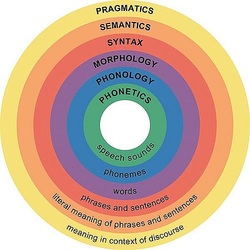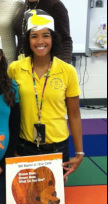How does English Linguistics help our students in the classroom?

"Where is my shoes?"
"I look out the vindow."
"What does 'You're on fire' mean? I'm not on fire!"
Teacher: "You said 'She go to the store.' Does that sound right?"
Student: "Yes? No?"
Here are some recent quotes and writing from students that I work with in the classroom. They are learning the complexities of English, as first graders and as English Language Learners (ELLs). At first glance, a teacher may quickly see incorrect grammar, pronunciation, spelling, or lack of vocabulary. However, there is much more at play for young students learning to read and write, especially for those who have a language other than English at home.
In learning more about the basics of English linguistics, we can better understand the structures and history of English, develop activities to help ELLs learn social and academic English in the four domains (speaking, listening, reading, and writing), and respect and incorporate students' language use, experiences, and proficiency in the classroom.
"I look out the vindow."
"What does 'You're on fire' mean? I'm not on fire!"
Teacher: "You said 'She go to the store.' Does that sound right?"
Student: "Yes? No?"
Here are some recent quotes and writing from students that I work with in the classroom. They are learning the complexities of English, as first graders and as English Language Learners (ELLs). At first glance, a teacher may quickly see incorrect grammar, pronunciation, spelling, or lack of vocabulary. However, there is much more at play for young students learning to read and write, especially for those who have a language other than English at home.
In learning more about the basics of English linguistics, we can better understand the structures and history of English, develop activities to help ELLs learn social and academic English in the four domains (speaking, listening, reading, and writing), and respect and incorporate students' language use, experiences, and proficiency in the classroom.
BUT... What is linguistics?
English Linguistics is the scientific study of the English Language. It explores the areas of phonology, morphology, syntax, semantics, pragmatics, and other related areas. From the basics of the sounds of English to the larger role of context in the meaning of English words, English is both a structured and fluid language.
On this site, you can learn some of the basics of each of these areas of linguistics, how they play a role in the English language development of students, and activities to help students learn social and academic English in the classroom.
On this site, you can learn some of the basics of each of these areas of linguistics, how they play a role in the English language development of students, and activities to help students learn social and academic English in the classroom.
Need more convincing about the importance of English Linguistics?
Read this article from the Center for Applied Linguistics (CAL) website:
"What Elementary Teachers need to know about Linguistics"
Read this article from the Center for Applied Linguistics (CAL) website:
"What Elementary Teachers need to know about Linguistics"
about me

As an elementary teacher of ELLs, I understand the complexities of teaching students with diverse backgrounds and language experiences. With 9 years teaching experience in a variety of school settings, I am always excited to share and learn from other teachers, specialists, and education professionals. I have had the amazing opportunities to work in a preschool, charter school in Washington DC, magnet school in Arlington, VA, and, currently, with Fairfax County Public Schools in Herndon, VA. Currently, I am an ESOL teacher (English for Speakers of Other Languages) at an elementary school, working with primarily kindergarten and first grade students.
Throughout my academic and teaching career, I have focused on the issues of closing the achievement gap and cultural and critical awareness. In the past few years, I have become particularly interested in learning more about ELLs and best practices for supporting ELLs for success in school and beyond. As part of my graduate coursework as an ESOL teacher, I have gained a better understanding of English Linguistics and the importance of this field of study in effective instruction of ELLs, and I hope to share what I have learned and create a website that can help us to collaborate as teachers and to showcase great resources for supporting ELLs in the classroom.
Throughout my academic and teaching career, I have focused on the issues of closing the achievement gap and cultural and critical awareness. In the past few years, I have become particularly interested in learning more about ELLs and best practices for supporting ELLs for success in school and beyond. As part of my graduate coursework as an ESOL teacher, I have gained a better understanding of English Linguistics and the importance of this field of study in effective instruction of ELLs, and I hope to share what I have learned and create a website that can help us to collaborate as teachers and to showcase great resources for supporting ELLs in the classroom.
